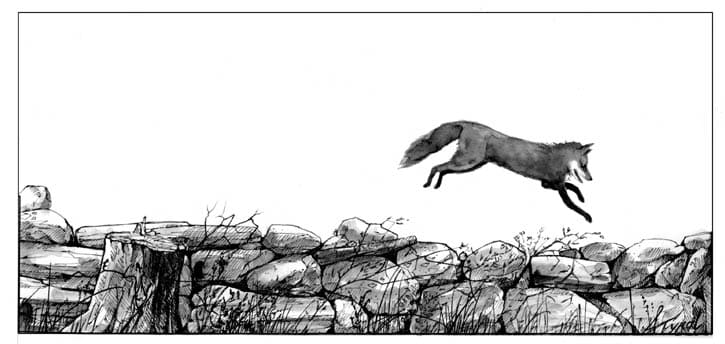By Joe Rankin
When you think about the iconic landforms of the Northeast, what comes to mind? The mountains, of course. The lakes. Of course. Rivers? Probably.
But there’s another. Stone walls. An estimated 100,000 miles of them. They might not be as impressive as the Presidential Range or Moosehead Lake, but collectively they make a big impact on the landscape and the creatures who live there.
Stone walls parse the land into finer pieces, creating diverse microclimates and ecosystems and opportunities for creatures of all types, said Robert M. Thorson, a University of Connecticut geology professor, the founder of the Stone Wall Initiative, and the author of three books about New England’s stone walls: “Stone by Stone: The Magnificent History in New England’s Stone Walls”; “ Exploring Stone Walls: A Field Guide to New England’s Stone Walls” and “Stone Wall Secrets” (co-authored with Kristine Thorson.)
In “Exploring Stone Walls,” he wrote that “when we encounter a stone wall in the deep woods, we instinctively think of the place as being desolate. This is an illusion. Every stone in every wall is animated with life.”
Stone walls literally change things from the soil level on up, Thorson told me in an interview. “Think about shade and sunlight and wind and the implications of that for moisture and temperature. Think about the structure of the wall and the conductivity of the stone relative to the ground. They’re heat pumps and ventilators.”
The base of stone walls might be cool and moist, the crevices like tiny caves. The top might be a desert, dry and barren. On one side of a wall might be woods, the other field. “Walls sort of divide, create and enforce differences,” Thorson said. If you have a wall on a slope it might be capturing soils on the upside, while the soils on the downside might be poorer. “That makes shade or not shade. You have upslope and downslope,” he said.
 Animals of all types utilize stone walls — from foxes to chipmunks to salamanders. Cats and foxes use them as travel lanes, while the extra elevation could help them spot prey, or predators. When my friends at Northern Woodlands brought in their game cameras last fall, they had some great shots of a bobcat and a black bear on a stone wall. Yes, a black bear.
Animals of all types utilize stone walls — from foxes to chipmunks to salamanders. Cats and foxes use them as travel lanes, while the extra elevation could help them spot prey, or predators. When my friends at Northern Woodlands brought in their game cameras last fall, they had some great shots of a bobcat and a black bear on a stone wall. Yes, a black bear.
Thorson said Blanding’s turtles migrate to breeding sites along stone walls, where the leaf litter is moister and there’s more protection from predators.
“It’s a wall, but it’s also a corridor,” Thorson told me. “You get wet and dry, shady, moist, windward and leeward. It introduces a vertical billboard to the landscape and increases habitat diversity.”
The immensity of the stone wall landform — New England’s stone walls are at least two times the length of the Interstate Highway System — means that is a lot of habitat.
While a single pile of rocks might attract a few chipmunks or white-footed mice, imagine that rodent-friendly habitat chained together for miles. Then think about the minks and snakes, the foxes and owls that prey on those rodents and you see how the effect is multiplied up the food chain. Stone walls can, literally, make our landscape come alive.
“I just think they’ve made the landscape much more interesting…because of the power of plant and animal communities to adapt to the changes they impose,” said Thorson.
When talking about the power of stone walls to attract animal life, Thorson likes to use us as an example. Take a bunch of second graders and assemble them in a field between a pond and a woods edged by a stone wall. Tell them to go find nature and they’ll head for the pond because, well, that’s where they’ve been taught that nature exists. Tell them to go explore, he said, and they’ll head right for the stone wall.
Many of us take stone walls for granted. But they are as vulnerable as anything else to human activity. While there are still an estimated 100,000 miles of them in New England, it’s worthwhile noting that, in 1939 mining engineer Oliver Bowles estimated their combined length at 259,000 miles, according to the Stone Wall Initiative.
If the rest of them were to disappear, “a surge of physical and biological changes would ripple through the landscape,” Thorson wrote in the epilogue to “Exploring Stone Walls.” Woodlands would blend together, soil erosion would increase, and billions of creatures would die, he wrote. What’s more, we would have lost a part of who we are.
New England is a place, Thorson wrote, where “human activities are so thoroughly blended into the otherwise natural landscape that the distinction between them is moot and meaningless.” Stone walls create “a landscape in which history and natural history are one in the same.”
Joe Rankin writes on forestry, nature and sustainability. He lives in Maine. The illustration for this column was drawn by Adelaide Tyrol. The Outside Story is assigned and edited by Northern Woodlands magazine, northernwoodlands.org, and sponsored by the Wellborn Ecology Fund of New Hampshire Charitable Foundation: [email protected].



